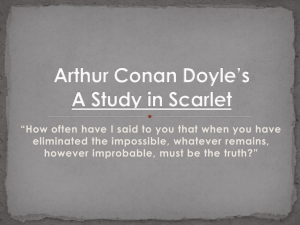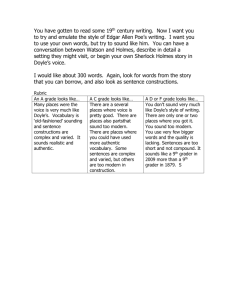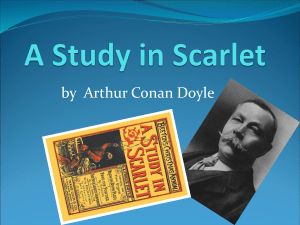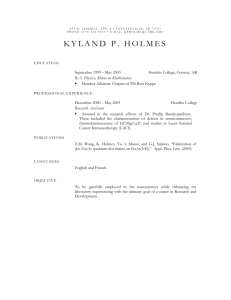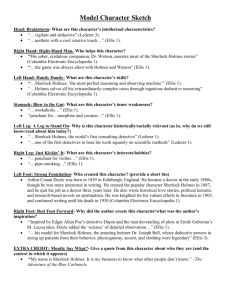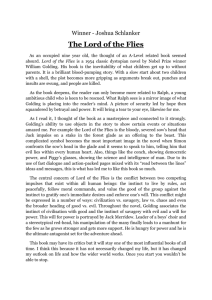NOVEL PLANNING SHEET
advertisement
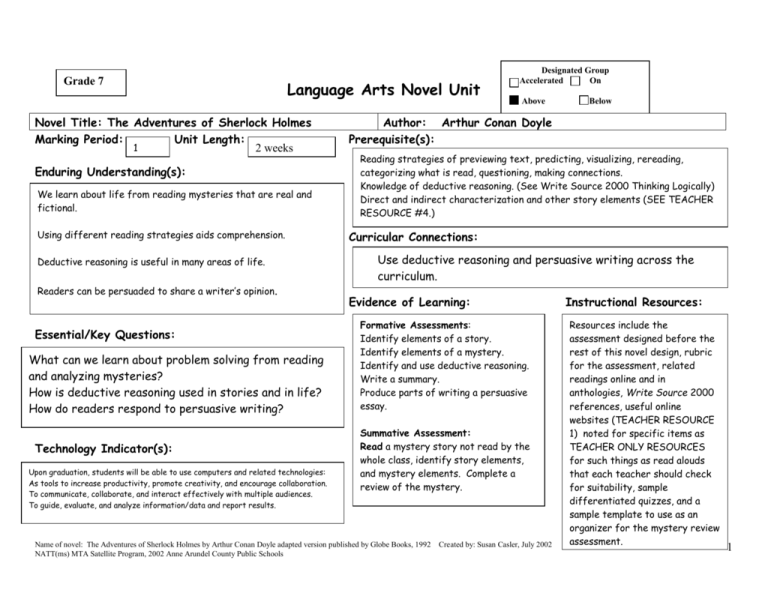
Grade 7 Language Arts Novel Unit Novel Title: The Adventures of Sherlock Holmes Marking Period: Unit Length: 1 2 weeks Enduring Understanding(s): We learn about life from reading mysteries that are real and fictional. Using different reading strategies aids comprehension. Deductive reasoning is useful in many areas of life. Readers can be persuaded to share a writer’s opinion. Essential/Key Questions: What can we learn about problem solving from reading and analyzing mysteries? How is deductive reasoning used in stories and in life? How do readers respond to persuasive writing? Technology Indicator(s): Upon graduation, students will be able to use computers and related technologies: As tools to increase productivity, promote creativity, and encourage collaboration. To communicate, collaborate, and interact effectively with multiple audiences. To guide, evaluate, and analyze information/data and report results. Designated Group Accelerated On Above Below Author: Arthur Conan Doyle Prerequisite(s): Reading strategies of previewing text, predicting, visualizing, rereading, categorizing what is read, questioning, making connections. Knowledge of deductive reasoning. (See Write Source 2000 Thinking Logically) Direct and indirect characterization and other story elements (SEE TEACHER RESOURCE #4.) Curricular Connections: Use deductive reasoning and persuasive writing across the curriculum. Evidence of Learning: Formative Assessments: Identify elements of a story. Identify elements of a mystery. Identify and use deductive reasoning. Write a summary. Produce parts of writing a persuasive essay. Summative Assessment: Read a mystery story not read by the whole class, identify story elements, and mystery elements. Complete a review of the mystery. Name of novel: The Adventures of Sherlock Holmes by Arthur Conan Doyle adapted version published by Globe Books, 1992 NATT(ms) MTA Satellite Program, 2002 Anne Arundel County Public Schools Created by: Susan Casler, July 2002 Instructional Resources: Resources include the assessment designed before the rest of this novel design, rubric for the assessment, related readings online and in anthologies, Write Source 2000 references, useful online websites (TEACHER RESOURCE 1) noted for specific items as TEACHER ONLY RESOURCES for such things as read alouds that each teacher should check for suitability, sample differentiated quizzes, and a sample template to use as an organizer for the mystery review assessment. 1 Read Aloud/Journal Topic Day 1 Outcome: Students will recall prior knowledge and experiences. Selection pages - _1 -- 5_____Focus 1 Procedure: 1. Read aloud from Encyclopedia Brown. Have students predict the format for the story. 2. Read the story and model aloud checking to see if the story fits the format students named. Journal writing: Students will write about a mystery they have observed in their lives. (Ex. An unexplained occurrence at home such as how did the milk top pop off inside the refrigerator? Why does a dog follow one family member? Why does the car radio fade in and out? Teacher Directed Reading Novel Planning Sheet Teacher Directed Writing Outcome: Students will preview text and graphic information by skimming and scanning. Procedure: KWL re: Sherlock Holmes. Examine the text structure. Read Preface and A Word from Dr. Watson for the purpose of understanding the exposition of the stories. Students will reread and take notes on the exposition: setting, characters of John H. Watson, Sherlock Holmes, Mycroft Homes, Mrs. Hudson. Outcome: Students will identify evaluate effective topic and closing sentences in published writing. Students will imitate the style of an author’s topic and concluding sentences. Procedure: The teacher will review the purposes of topic sentences. The teacher will model how to identify topic sentences. The teacher will also identify concluding sentences. Working in pairs, students will identify topic and concluding sentences for the section: “A Word from Dr. Watson.” With one computer in the classroom, students will share their information on the exposition and create a graphic display using Inspiration. Students will see how the information is translated into an outline form. This outline will be used throughout the readings to see how knowing character traits can help a reader predict events. Students will copy the information from the Inspiration outline to use throughout the unit. Homework: Review the Inspiration notes. Name of novel: The Adventures of Sherlock Holmes by Arthur Conan Doyle adapted version published by Globe Books, 1992 NATT(ms) MTA Satellite Program, 2002 Anne Arundel County Public Schools Word Development Outcome: Students will be able to use writing terms to analyze selected readings. Procedure: In the Write Source 2000 (copyright 1993) students will read the section “Building Paragraphs” sections 75 and 76. Students will construct definitions for the following terms from the information presented: paragraph, topic sentence, body, closing, clincher sentence, formula. Homework: Study these terms of the Language Arts discipline for a quiz. Created by: Susan Casler, July 2002 Technology Outcome: Students will understand how to take ideas and organize them effectively by using Inspiration. Procedure: With one computer in the classroom, students will share their information on the exposition and create a graphic display using Inspiration. Students will see how the information is translated into an outline form. This outline will be used throughout the readings to see how knowing character traits can help a reader predict events. Students will copy the information from the Inspiration outline to use throughout the unit. 2 Selection pages - 6 -- 27 Focus 2-Plan A Read Aloud/Journal Day 2. Outcome: Students will make inferences or draw conclusions based in part on tone of voice, mood, and emotion in communication. Procedure: Read aloud from the “The Speckled Band.” Read exposition (p. 6 – 11 to the death of Julia. See Teacher Resource 2. Journal writing What observations can you make about one of the story’s main characters? Determine if you have used information that is direct or indirect characterization. Teacher Directed Reading Outcome: Students will establish a purpose for reading. Students will analyze characterization as delineated through a character’s thoughts, words, speech patterns, and deeds. Teacher Directed Writing Outcome: Students will write to explain the author’s use of deductive reasoning. Procedure: Choose one approach: Students will review deductive reasoning. Their purpose for reading will be to see how deductive reasoning is used to solve the mystery in this story. See Teacher Resource 3 for suggestions of evidence of deductive reasoning. After the teacher models finding and explaining evidence of deductive reasoning, students can be grouped in pairs, trios, or quads to find and explain just a portion of the deductive reasoning in the story. See the stance questions at the end of the Teacher Resource 3 for additional writing suggestions. Using a graphic organizer to record evidence of deductive reasoning, students will read from the telling of Julia’s death in the exposition (p. 11 Globe edition) to the end of the story. (p. 27) Name of novel: The Adventures of Sherlock Holmes by Arthur Conan Doyle adapted version published by Globe Books, 1992 NATT(ms) MTA Satellite Program, 2002 Anne Arundel County Public Schools Word Development Outcome: Technology Outcome: Students will be able to use context clues to determine the meaning of words in the story. Students will communicate, collaborate, and interact effectively with multiple audiences. Students will be able to use mystery genre terms appropriately. Procedure: Depending on the text selected and the level of students, word development will vary. The title, “The Speckled Band,” needs to be explored for the multiple meanings of the words Procedure: Use of Inspiration by several pairs for teacher directed writing. See Teacher Resources 4, 5 & 6 for several lists of mystery terms, literary terms, including one list with definitions provided. Assign a number of mystery terms to study. Created by: Susan Casler, July 2002 3 Focus 2 Day B Selection pages - _6 – 27 Read Aloud/Journal Topic Outcome: Day 3 Students will apply listening skills, using note taking to assist listening. Procedure: Students will listen and record the author’s use of suspense in the story read yesterday, “The Adventure of the Speckled Band.” The teacher will read parts showing suspense: p. 7 “Good morning, madam, …It is terror.”p.8 “That is just the trouble.. I am terribly afraid…I assure you.”p. 22 – 24 “It was almost eleven o’clock when we saw a single light flash up in a window of the dark house” “What can it mean?” I gasped… Teacher will note word choices and style choices that build suspense. JOURNAL: Recount a suspenseful time without giving away how the event ended. Teacher Directed Reading Teacher Directed Writing Word Development Outcome: Students will read to analyze the author’s use of suspense. Outcome: Students will be able to indicate a clear beginning, middle, and end to a story. Procedure: Procedure: Students will read “The Adventure of the Blue Carbuncle” (Globe edition pp. 50 – 69) (See Word Development for vocabulary to introduce before reading the story.) After introducing words students may not understand, the teacher will direct students to search the story for the element of suspense. Students should review the pattern of suspense Conan Doyle used in “The Speckled Band” and predict how suspense will be built up in this story. Students will outline “The Adventure of the Blue Carbuncle.” One or several students will work at computers in the classroom. Other students will work on paper. Students will revisit the text to make sure that they include the most pertinent information. Students will compare their outlines with several others. Students will report to the whole group their findings of similarities and differences of outlines. Students will analyze the strengths and weaknesses of various approaches. Outcome: Students will determine influences on word meanings and use mystery genre terms. Procedure: Introduce vocab. in directed reading: Name of novel: The Adventures of Sherlock Holmes by Arthur Conan Doyle adapted version published by Globe Books, 1992 NATT(ms) MTA Satellite Program, 2002 Anne Arundel County Public Schools carbuncle – a precious gem, toughs – ruffians, thugs; gas laid – natural gas piped into a building, a common energy source in the 19th century before the widespread use of electricity or oil; tallow – drippings from a candle; bonny – Scottish word for good; peculiar with him – unique to a person; infamous – notorious, wellknown but rotten. Technology Outcome: Students will use a template when assessed for knowledge of vocab. Procedure: See template as Teacher Resource 6, for use after several days when all mystery vocabulary has been introduced and direct and indirect characterization has been mastered. See Teacher Resources 4, 5, & 6 for several lists of mystery terms, including one list with definitions provided. Assign a number of mystery terms. Created by: Susan Casler, July 2002 4 Selection pages - ______ Focus 3 Student Selected Read Aloud/Journal Topic Outcome: Students will apply listening skills to identify author’s use of characterization to predict events, suspense, and deductive reasoning. Procedure: Over several days, read “The Redheaded League” from an anthology modeling finding author’s characterization leading to events, use of suspense, and evidence of deductive reasoning. Teacher Directed Reading Novel Planning Sheet Teacher Directed Writing Word Development Technology Outcome: 2 –3 days Students will read to identify author’s use of characterization to predict events, suspense, and deductive reasoning Outcome: Students will use an organizer to categorize knowledge about story and mystery elements. Outcome: Students will use context clues, prior knowledge, inferencing, and reference materials to determine meaning of self-selected words. Outcome: Students will use a template when assessed for knowledge of vocabulary. Procedure: From The Adventures of Sherlock Holmes and the Teacher Resource 7 list, students will select three stories to read for the purpose of writing a review critiquing author’s use of characterization to predict events, suspense, and deductive reasoning. Procedure: Procedure: Procedure: Using the template, TEACHER RESOURCE 8, students will identify and analyze story and mystery elements in preparation for writing their review of a mystery story. Students can work in pairs to share their information with students who have read the same story. From self-selected stories, students will find up to three words in each story for which they had to use a context clue, prior knowledge, inferencing, or a dictionary or other source to determine the meaning as used in the text. Students will record their words, context, and strategies and share them with groups. See template as Teacher Resource 8, for use during directed writing. Journal: Students can write about the author’s characterization, use of suspense, or use of deductive reasoning for the story selection read this day. Name of novel: The Adventures of Sherlock Holmes by Arthur Conan Doyle adapted version published by Globe Books, 1992 NATT(ms) MTA Satellite Program, 2002 Anne Arundel County Public Schools Created by: Susan Casler, July 2002 5 Read Aloud/Journal Topic Teacher Directed Reading Novel Planning Sheet Teacher Directed Writing Word Development Outcome: Students will write to inform. Writing Day Procedure: Procedure: Continued from page 5. Procedure: This will be a three or four day or step procedure. Students will use the three templates they have completed as their resource material. Then they will compose an organizer for the specific topic of the writing assessment. SEE TEACHER RESOURCES 9 AND 10. Students will compose a rough draft, following the directions of the prompt and rubric. They will revise, proofread, and compose a final draft. Some of the steps may be completed as a homework assignment, or on subsequent days. As a whole group, students will publish their pieces electronically. Name of novel: The Adventures of Sherlock Holmes by Arthur Conan Doyle adapted version published by Globe Books, 1992 NATT(ms) MTA Satellite Program, 2002 Anne Arundel County Public Schools Technology Outcome: Students will word process their final proofreading and draft. Procedure: Continued from page 5 Created by: Susan Casler, July 2002 Procedure: Teacher will review word processing guidelines. Teacher will model using a spelling and grammar checker. Teacher will model saving information in correct e-file. 6 Novel Planning Sheet Reading Day Teacher directed reading. Students will compare and contrast knowledge with prior information. Technology Students will evaluate persuasive writing based on their knowledge of mystery writing. The teacher will model using the electronic collection of reviews of mystery stories. The teacher will also model how using the electronic file reviewing many stories can help students choose additional stories to read. For closure, students will share the info they found. As a whole group, students will visit the computer lab to read the bookmarked site where all student mystery reviews are published. They will read a variety of reviews from their immediate classmates and other students from their grade and compare the reviews to their own. The teacher will model this activity. Students will take notes about other mystery story reviews they read online, and write why they would or would not like to read the novel based on the review. Name of novel: The Adventures of Sherlock Holmes by Arthur Conan Doyle adapted version published by Globe Books, 1992 NATT(ms) MTA Satellite Program, 2002 Anne Arundel County Public Schools Created by: Susan Casler, July 2002 7 Generic Plot Summary for Most Adventures of Sherlock Holmes Parts of the Plot Exposition Generic Summary Each Sherlock Holmes’ adventure starts at 221 B Baker Street, London, England, in the late 19 th century. Holmes and Watson meet a victimized person who explains the problem to them. Holmes reveals his deductive reasoning ability to this visitor by telling about the visitor’s personal life from astute observations made by Holmes. Rising Action From questions asked by Holmes, he then institutes a plan of action, but the reader is not privy to his thoughts. Generally one danger occurs while initiating this plan of action. Climax Holmes’ plan works with a close call of danger to himself, Watson, and/or others. The suspense builds until the major dangerous act occurs. Falling Action Resolution Holmes reveals how he solved the problem. After the problem is solved and the process of deductive reasoning is revealed, Holmes reverts to his quiet life at 221 B Baker Street. Name of novel: The Adventures of Sherlock Holmes by Arthur Conan Doyle adapted version published by Globe Books, 1992 NATT(ms) MTA Satellite Program, 2002 Anne Arundel County Public Schools Created by: Susan Casler, July 2002 8 Selection Summaries: About the Author and Preface, The Adventures of Sherlock Holmes, Globe edition, 1992. A Word From Doctor Watson, p. 1 - 5 The Adventure of the Speckled Band pp. 6 - 27 The Adventure of the Blue Carbuncle pp. 50 69 Background information on Arthur Conan Doyle. Additional teacher information is on (mysterynet.com). The preface helps the reader understand the differences between the stories’ setting and current times. John H. Watson, M.D., the narrator of all Holmes’ stories, writes a letter explaining how he and Holmes met, and why he recorded the adventures. Watson gives insight into Holmes through direct characterization, and to himself through indirect characterization. The letter helps the reader understand the friendship between Holmes and Watson, and the qualities of both. This ‘locked-room’ mystery opens with Helen Stoner explaining to Holmes and Watson how she broke into her sister’s locked room at the family estate of her stepfather, Dr. Roylott. After speaking incoherently about a speckled band, Julia dies in Helen’s arms. Through a series of questions, Holmes determines that no entry was possible by any human into the room. A series of clues leads Holmes to the deduction that he will encounter the murderer within the locked room. He does, and later reveals how he determined Dr. Roylott’s plan to murder his stepdaughter for her inheritance. One Christmastide, Holmes explains to Watson how a rare blue carbuncle was found in a butchered goose. Through keen observation and deductive reasoning, Holmes solves the seemingly unsolvable: finding the owner of goose, leading to the breeder of the goose, leading to the one who ‘fed’ the gem to the goose, the thief of the gemstone. An unusual revelation is Holmes’ compassion for the thief, whom he releases because it is the season of peace on earth, good will to all. Name of novel: The Adventures of Sherlock Holmes by Arthur Conan Doyle adapted version published by Globe Books, 1992 NATT(ms) MTA Satellite Program, 2002 Anne Arundel County Public Schools Created by: Susan Casler, July 2002 9

